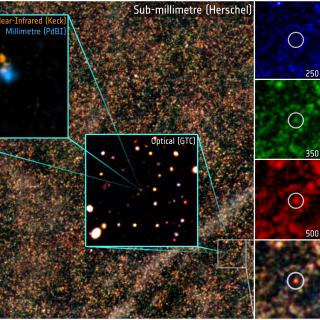Riechers, Dominik A.; Cooray, A.; Omont, A.; Neri, R.; Harris, A. I.; Baker, A. J.; Cox, P.; Frayer, D. T.; Carpenter, J. M.; Auld, R.; Aussel, H.; Beelen, A.; Blundell, R.; Bock, J.; Brisbin, D.; Burgarella, D.; Chanial, P.; Chapman, S. C.; Clements, D. L.; Conley, A.; Dowell, C. D.; Eales, S.; Farrah, D.; Franceschini, A.; Gavazzi, R.; Glenn, J.; Griffin, M.; Gurwell, M.; Ivison, R. J.; Kim, S.; Krips, M.; Mortier, A. M. J.; Oliver, S. J.; Page, M. J.; Papageorgiou, A.; Pearson, C. P.; Pérez-Fournon, I.; Pohlen, M.; Rawlings, J. I.; Raymond, G.; Rodighiero, G.; Roseboom, I. G.; Rowan-Robinson, M.; Scott, K. S.; Seymour, N.; Smith, A. J.; Symeonidis, M.; Tugwell, K. E.; Vaccari, M.; Vieira, J. D.; Vigroux, L.; Wang, L.; Wardlow, J.; Wright, G.
Referencia bibliográfica
The Astrophysical Journal Letters, Volume 733, Issue 1, article id. L12 (2011).
Fecha de publicación:
5
2011
Número de citas
59
Número de citas referidas
56
Descripción
We report the detection of CO(J = 5 → 4), CO(J = 3 → 2), and
CO(J = 1 → 0) emission in the strongly lensed,
Herschel/SPIRE-selected submillimeter galaxy (SMG) HERMES
J105751.1+573027 at z = 2.9574 ± 0.0001, using the Plateau de
Bure Interferometer, the Combined Array for Research in Millimeter-wave
Astronomy, and the Green Bank Telescope. The observations spatially
resolve the molecular gas into four lensed images with a maximum
separation of ~9'' and reveal the internal gas dynamics in this system.
We derive lensing-corrected CO line luminosities of L'CO(1-0)
= (4.17 ± 0.41), L'CO(3-2) = (3.96 ± 0.20), and
L'CO(5-4) = (3.45 ± 0.20) × 1010
(μL/10.9)-1 K km s-1 pc2,
corresponding to luminosity ratios of r 31 = 0.95 ±
0.10, r 53 = 0.87 ± 0.06, and r 51 = 0.83
± 0.09. This suggests a total molecular gas mass of M
gas = 3.3×1010 (αCO/0.8)
(μL/10.9)-1 M sun. The gas mass, gas
mass fraction, gas depletion timescale, star formation efficiency, and
specific star formation rate are typical for an SMG. The velocity
structure of the gas reservoir suggests that the brightest two lensed
images are dynamically resolved projections of the same dust-obscured
region in the galaxy that are kinematically offset from the unresolved
fainter images. The resolved kinematics appear consistent with the
complex velocity structure observed in major, "wet" (i.e., gas-rich)
mergers. Major mergers are commonly observed in SMGs and are likely to
be responsible for fueling their intense starbursts at high gas
consumption rates. This study demonstrates the level of detail to which
galaxies in the early universe can be studied by utilizing the increase
in effective spatial resolution and sensitivity provided by
gravitational lensing.
Proyectos relacionados

Formación y Evolución de Galaxias: Observaciones Infrarrojas y en otras Longitudes de Onda
Este grupo desarrolla varios proyectos extragalácticos en diferentes rangos del espectro electromagnético utilizando satélites y telescopios en tierra para estudiar la evolución cosmológica de las galaxias y el origen de la actividad nuclear en galaxias activas. En el aspecto instrumental, el grupo forma parte del consorcio internacional que ha
Ismael
Pérez Fournon